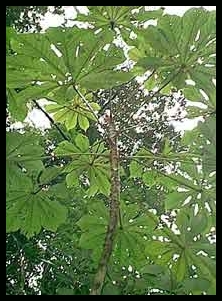A brand new family
of didgeridoos is out now, made out of a very special tree called Embaúba (Cecropia sp., Cecropiaceae), very common in Brazil. This
species, which can reach till 15 meters (50 ft) tall, has a very interesting
characteristic: it's a home for ants. This tree produces crystals of sugar
underneath its big hand-like leaves, offering this sweet food to the ants. And
moreover: it also offers a place for them to live. Embaúba's trunk and branches
are hollow, divided only by slender internal membranes all the way through, and
with some entrances for the ants can be found from the outside. The ants, in
return, protect the tree against plagues and other small herbivorous animals. In
the North of Brazil, this plant is the preferred food for the sloth (Bradypus
sp.), what also gives another name to this tree: sloth-plant.
called Embaúba (Cecropia sp., Cecropiaceae), very common in Brazil. This
species, which can reach till 15 meters (50 ft) tall, has a very interesting
characteristic: it's a home for ants. This tree produces crystals of sugar
underneath its big hand-like leaves, offering this sweet food to the ants. And
moreover: it also offers a place for them to live. Embaúba's trunk and branches
are hollow, divided only by slender internal membranes all the way through, and
with some entrances for the ants can be found from the outside. The ants, in
return, protect the tree against plagues and other small herbivorous animals. In
the North of Brazil, this plant is the preferred food for the sloth (Bradypus
sp.), what also gives another name to this tree: sloth-plant.

Where do you get the trees to make
your didgeridoos?
The trees are not cut down! I look
for trees already cut, or naturally fallen. This tree is very common in the
island I live, in the South of Brazil, but even like that I'm against cutting
these trees down, also because there would be ants living inside while the plant
is alive.
What is so special about the
didges made out of these trees?
Because it's hollow in almost all
the tree, you can find many shapes of didgeridoos, from the thick to the
slender, from the long to the short ones. The fibers arrangement also helps in
creating a very nice sound. The embaúba tree has a soft wood, what makes the
weight much lighter than other types of didgeridoos. The way inside is covered
by a black natural hard substance, what helps in creating a consistent sound.
The surface is naturally covered with beautiful drawings, all done by fungus and
some other microorganisms. The indigenous people Caraíbas used to use this tree
to make musical instruments.
You have the guarantee that these instruments are produced from fallen
trees (well, at least my word), have the attention of a small scale production,
and the paintings and shapes are all handmade (with exception of those made by
nature). So, support nature friendly production! ;)

 |
Check
out the didgeridoos!
1.
Formiga
2. Larva
3. Pau Vermelho
4. Pau Branco
5. Sino I
6. Sino II
7. Terra I
8. Tortuoso I
9. Semente
10. Trepadeira
11. Terra II
12. Tortuoso II
|
Updated in July
2002

Contacts:
c/o Thales Tréz
Rua Walter de Bona Castelan, 512
Jardim Anchieta
CEP 88037-300 Florianópolis/SC
Brazil
e-mail: thalestrez@yahoo.com
